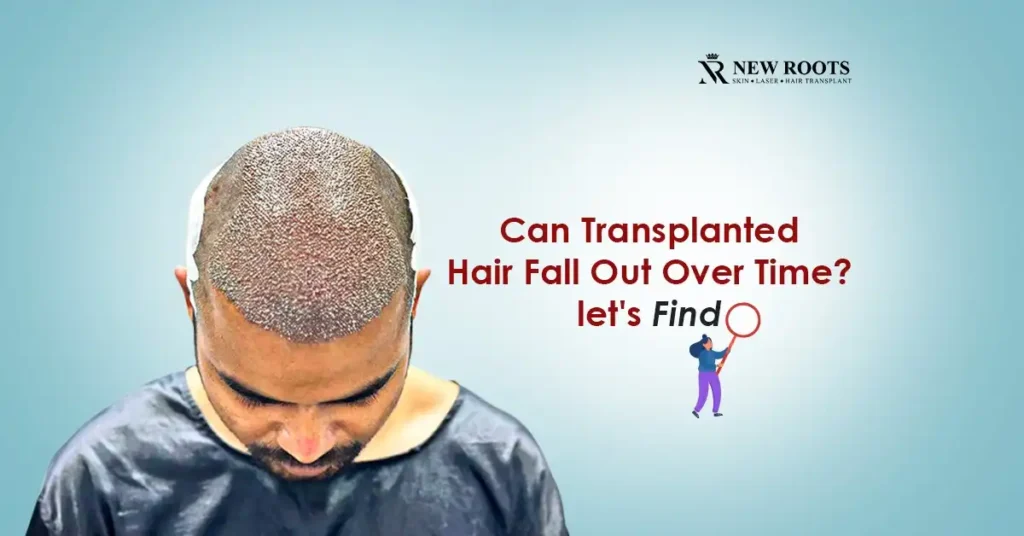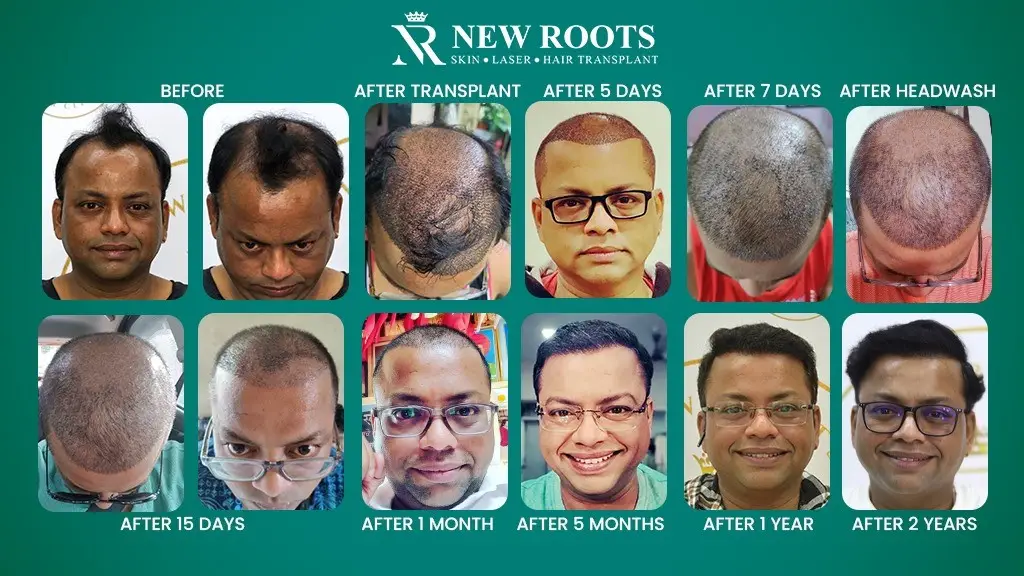Introduction
Baldness, especially accompanied by hair thinning, is a severe and worrying problem that has become more apparent in today’s society, irrespective of age, sex, or race. It may be caused by genetic, hormonal, medical, and environmental factors or their combinations.
Even though male-pattern baldness is traditionally related to the male elderly, today, hair thinning and loss are issues that affect growing numbers of women causing low self-esteem and related psychological problems.
However, amidst the enthusiasm for hair transplants, a pertinent question often arises: can transplanted hair fall out? Of such concern is the matter concerning the viability and strength of the transplanted follicles and their ability to grow post-surgery.
Loss of hair is one of the fears that candidates may have towards the process of hair transplant hence they too may lag back on the process.
Table of Contents
Understanding Hair Transplants
Explanation of Hair Transplant
Hair transplant also known as hair restoration surgery is a surgical process in which the hair follicles are lifted from the donor area and then planted to the recipient area.
This method is useful for those who face the problem of androgenetic alopecia, pattern baldness, or other similar procedures.
There are two primary techniques utilized in hair transplantation:
Follicular Unit Extraction (FUE):
In this technique, single hair follicles are then taken from the donor area with the help of a particular tool, which leaves almost no cuts behind.
This technique is better as it concerns implantation since it will be done follicular by follicular and the hairdresser will have enough time to ensure optimal, natural, and correct placement.
The recovery process is also usually faster with less pain and discomfort after surgery and that is why the procedure attracts quite several people.
Follicular Unit Transplantation (FUT):
FUT also called the strip method, requires a donor strip to be excised from the region of the scalp. The strip is then trimmed into many small grafts of one or two follicular units each to be implanted.
This technique also has the potential of providing more grafts from the body in one procedure but leaves a line scar on the head. Nonetheless, the recovery period will slightly be longer compared to FUE as the incision takes time to heal.
The Biology of Transplanted Hair
How Hair Growth Works
It is not possible to discuss the question, can transplanted hair fall out? without understanding hair growth. Hair follicles go through various cycles: a somatic growth phase called anagen, a transitional phase called catagen, and a resting phase called the telogen.
It should be noted that once the hair follicles have been transplanted, they should be able to go through these cycles on their own.
For Organ Transplant, five phases have been observed which include the theoretical phase, the inflammatory phase, the healing phase, the first phase of growth phase, and the second phase of growth phase.
Transplanted hair usually goes into a dormant phase and most patients undergo a shock phase often characterized by the shedding of transplanted hair. But this is quite natural and the hair undergoes a resting phase; the hair will start growing again gradually after this phase.
Can Transplanted Hair Fall Out?
One of the important questions that a person who is thinking about Hair Transplantation has to ask is whether the transplanted hair can be shed. Despite the hope most clients carry to their transplanted hair as a permanent solution, various elements can lead to the shedding of these newly transplanted follicles.
Physical Trauma
One major cause of hair loss after a hair transplant is tissue injury to the head area, still, this can not be one hundred percent proven. This can be a result of several activities that impose pressure or stress on the affected region of the head during the critical recovery period after surgery.
For instance, when a patient has an impact or when excessive manipulation is made on the hair, the trauma results in either displacement or damage of hair follicles.
As it can be seen, physical trauma as a cause of hair loss underlines that the scalps should be handled very gently during the first few days of the new year.
Shock Loss
Shock loss is a common occurrence after hair transplant surgery and usually, it is a temporary condition that affects many people. This condition develops usually in the telogen phase, which is a resting phase in the hair growth cycle, in which scalp hairs could shed due to the surgical trauma.
One of the issues that can cause a lot of distress in patients is shock loss because many of the patients expect that the hair transplanted is not growing. This is quite typical in hair transplants; the majority of shock loss is shed hair, which comes back after a couple of months once the hair follicles have recovered.
Underlying Conditions
Having other diseases also impacts the health of transplanted hair as well as other body parts and systems; hence, potential recipients should declare their health conditions truthfully.
Problems like seborrhea, ringworm infections, and any other skin conditions that may exist can pose a threat to the health and the general condition of follicles.
Any medical conditions that affect the scalp health may cause hair loss if a patient has such a condition chances of hair loss after transplant may occur.
It is thus advisable to first take a health check of the patients and treat all their health complications before you take them through hair transplant surgery.
Non-compliance with Post-op Guidelines
Aftercare treatment recommended by the surgeon is a critical determinant if hair transplantation is to succeed. It was established that patients, who did not follow all the post-operative recommendations very carefully, had higher potentiality to face complications such as hair loss.
Such guidelines may encompass messages regarding the topical application on the scalp area, limitations on any sort of physical exertion, and rules concerning cleanliness.
Failure to adhere to such requirements can slow the healing process creating more stress on the hair follicles and subsequent hair loss.
That is why, proper adherence to these guidelines is critical for maintaining the outcome of hair transplant and stimulating healthy hair regrowth.
Factors Influencing Hair Transplant Success
Quality of Donor Hair
The characteristics of the donor area’s hair also have a significant influence on hair transplant effectiveness. The donor hair is usually taken from less vulnerable parts of the head normally found at the back or sides of the scalp.
In case the hairs that are to be used as donors are thin, weak, or are genetically categorized as being prone to developing baldness they may not be able to support the transplantation procedure.
Lack of strength in the donor's hair leads to a poor prognosis when some of the hair transplanted either does not grow at all or they do not achieve a density as required.
Therefore, the donor area’s examination is critical, and it is preferable to transplant higher-quality, dense hair shafts, which would increase the effectiveness of the hair restoration surgery.
Post-surgery Care
After the task of hair transplant is done the correct aftercare is of utmost importance to make sure that transplanted hair roots remain healthy.
Instructions range from avoiding vigorous exercise and wearing caps over the scalp to all types of costumes; the necessary medication schedule must also be strictly followed by the patient.
These measures assist in reducing the possibilities of shock loss, infection as well as harm to the newly transplanted grafts. Adherence to the guidelines further supports the processes of healthy recovery while also advancing the possibility of achieving the intended appearance goals.
The complete avoidance of these practices is deadly and will lower the transplant success rate considerably.
Why Does Hair Fall Out After Transplantation?
Transplantation is a common technique recommended for patients who want to get a new look or have lost hair due to various causes, but whose hair falls out after transplantation.
1. Normal Shedding Process
A normal occurrence nowadays is shock loss, which is a reaction of transplanted hair to shedding not long after the operation. This hair loss occurs during the transitional stage of the hair growth mechanism, and it is most often natural.
The new hair follicles undergo some certain stress maybe due to transplantation and therefore within two to three weeks up to one-half of the shafts may shed as they prepare for a new growth cycle.
This process can make transfixed say, transplanted hair fall out, sit and watch their newly transplanted hair strands fall off or shed.
2. Physical Abuse to the Head and Particular Reference to the Scalp
Harm to the scalp physically after the surgery affects the graft survival rate greatly.
It is also recommended that to prevent any harm in the follicular units, one should not engage in any rigorous movements that involve exercises in the following days of a transplant.
If the scalp endures bumps, impacts, or excessive manipulation, it may lead to dislodging or damaging the grafts, answering the query: does transplanted hair grow again and can the hair fall out?
3. Underlying Medical Conditions
Some of the other long-term illnesses can cause hindrance to hair growth and also lead to baldness in the transplanted zones. Any disease that may hinder blood flow and nutrition to the hair root such as diabetes, thyroid, and various diseases of the scalp, can hinder normal hair growth.
When it comes to treatment, these health issues need to be well-managed to produce good results; otherwise, the answer to the question – of can transplanted hair fall out – might become obvious.
Understanding the Lifespan of Transplanted Hair
Factors affecting the longevity of the transplanted hair Nature of the transplanted hair follicle Health.
If skin and hair follicles that will host the transplanted hair are healthy, one can have it throughout his entire life. Unlike natural hair that can be affected by various factors and shed off at any one time, the hair follicles transplanted are obtained from areas that are not affected by hormonal issues on thinning and therefore are not likely to experience the same fate.
Thus, it is possible to conclude that the factors affecting the ability of transplanted hair to fall out are closely related to external factors that can be effectively addressed in practice.
Solutions to Prevent Hair Fall Post-Transplant
Medications
To make the hair healthier and minimize the possibility of hair shedding after transplant procedures, the medical Doctor prescribes Minoxidil and Finasteride.
Minoxidil is a topical solution that is used in the treatment of pattern baldness since it aids in the improvement of the follicle function through the enhancement of blood flow. It is usually in a solid form and is used directly on the affected areas hence needs to be used repeatedly to produce the best outcomes.
It is a tablet taken orally that acts as a 5- 5-alpha-reductase inhibitor; this reduces the conversion of testosterone to DHT which results in hair loss.
Through lessening the DHT level, Finasteride preserves the scalp hair and is useful for the transplant recipient’s impacted hair follicles. These two are part of the post-transplant treatment and support stronger hair growth than the chances of more hair loss.
Lifestyle Changes
Some specific changes are grand in the direction of enhancing general health and the health of hair separately. Most are familiar with the food pyramid; in the same way, there is the nutrient pyramid which should be taken in proportion and include the vitamins and minerals that are good for the hair these include vitamin D, biotin, and zinc among others.
Another factor that needs to be addressed is the consumption of water because the skin, hair, and hair follicles require moisture to remain healthy.
Also, stress is another factor that can contribute to the deterioration of hair, and techniques like exercising, meditating, or any other typical practical activity can help to cope with the stress.
Stress is strongly associated with hair loss; therefore, stress management is crucial for those willing to achieve the best outcomes of hair transplantation.
New Roots clinic
New Roots – Skin, Laser & Hair Transplant Clinic is yet to commence the provision of aesthetic services where it will treat the skin and hair. Handling beauty treatments with care while making them scientific is done at this reputable clinic through dermatologists and trichologists.
New Roots Clinic is a well-equipped hair and skin solution clinic that started its operations in the year 2011 with the FDA-approved latest technology-equipped clinic.
Key Points
– Organization of New Roots Clinic
New Roots – Skin, Laser & Hair Transplant Clinic is a start-up clinic dealing with aesthetic treatments, which will be opening its branch in Pune on 15th August. It is a clinic that focuses on hair transplant surgeries as well as dermatology services.
– Services Offered
Aesthetic procedures for many skin and hair-related problems are offered.
As a result of such classification, it is possible to develop individualized programs about the needs of each patient.
– Expertise and Technology
Highly professional dermatology and trichology practitioners are also employed at this company.
Uses the latest technology and US-FDA-approved laser for the treatments.
Boasts put into use other advanced medical knowledge for the accomplishment of satisfactory results.
– Commitment to Patients
Boasts of reliability, safety, and cheap solutions on their website and to their clients.
Concentrating on delivering predictable outcomes for clients since the year 2011.
Hopes to acquire the role of the go-to brand for all hair and skin issues.
Conclusion
To sum up, the described question as well as its answer can be formulated as follows: is a reasonable question, if the biological profiles of hair growth are comprehended, post-operative directions adhered to, feasible health conditions controlled, and life changes adopted improvements to hair transplants are bound to be realized.
These elements mean that one can easily keep hair restoration solutions for longer, as well as have natural-looking hair growth.
Q&A ASK :
Yes, transplanted hair can shed minimally over time because of several factors such as the wrong post-surgery regime and others. The majority of the transplants are permanent but in areas that have not been treated, balding can continue.
It was observed that if they are excellent, hair transplants hold hair growth after 10 years; nevertheless, the patient may start to see signs of aging and hair thinning. The nature of the transplanted hair can be different because of the distinct surgical method used and the overall patient’s treatment over the years.
Yes, a hair transplant can become an unsuccessful procedure as the following contributions from real people explain.
Indeed, it is possible to encounter a hair transplant failure whose frequency depends on several factors: its average percentage is 43%. The immediate causes of transplant failure and poor outcomes include improper preparation, faulty cutting, poor sutures, and improper care of grafts as well as insufficient donor region.
Yes, it is normal for some grafts to shed off within the first month after the surgery because of shock loss. However, transplanted follicles heal and enter the anagen phase of hair growth months after the procedure is done.
T transplanted hair may shed off after two years although the instances are rather rare. Possible reasons for this could be ineffective suturing, inadequate blood circulation, or continued shedding of hair in areas yet to be operated on hence having a less pleasing appearance.
Indeed, transplanted hair can shed in male patients and this is basically due to genes embedded in the male pattern baldness proliferation. Hormonal changes, people’s diseases, and necessary medical treatment can lead to the weakening or complete loss of previously transplanted hair






